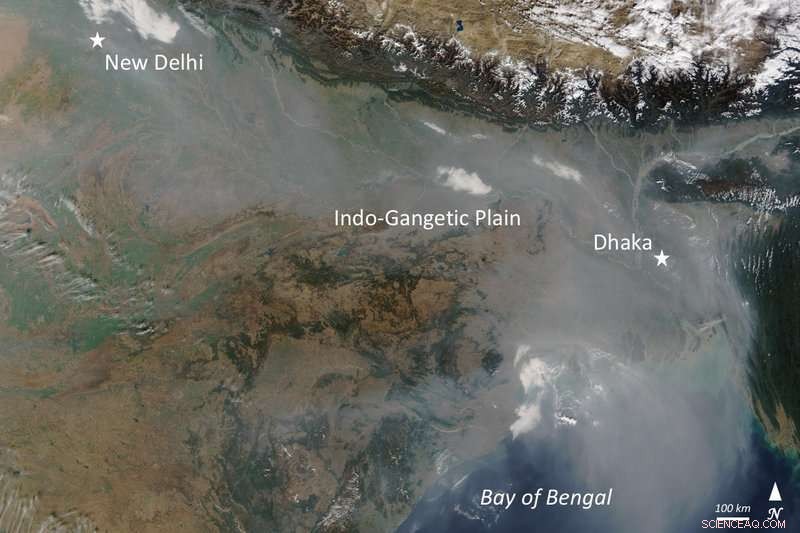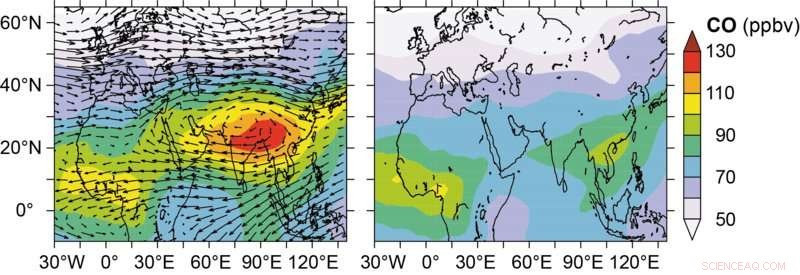As monções do sul da Ásia purificam com eficiência os poluentes do ar, mas também os distribui por todo o mundo
 p Uma enorme nuvem de poluição sobre o sul da Ásia:a nuvem marrom atmosférica é criada durante os meses de inverno todos os anos pela combustão de biomassa e combustíveis fósseis. Crédito:NASA, Jeff Schmaltz, Resposta Rápida LANCE / EOSDIS
p Uma enorme nuvem de poluição sobre o sul da Ásia:a nuvem marrom atmosférica é criada durante os meses de inverno todos os anos pela combustão de biomassa e combustíveis fósseis. Crédito:NASA, Jeff Schmaltz, Resposta Rápida LANCE / EOSDIS
p O mesmo fenômeno ocorre todos os anos. Durante a estação seca, no inverno, queimar combustíveis fósseis e biomassa no sul da Ásia cria uma enorme névoa de poluição:a nuvem marrom atmosférica. Como e por que ele desaparece assim que a estação das chuvas começa na primavera, agora foi esclarecido por uma equipe internacional de cientistas liderada pelo Instituto Max Planck de Química. O resultado é que; atualizações de tempestade, raios e reações químicas aumentam o poder de autolimpeza da atmosfera, permitindo que os poluentes atmosféricos sejam eliminados do ar de maneira eficiente. Contudo, os poluentes que não são eliminados são transportados para a alta troposfera pela monção e depois se espalham pelo mundo. p Nenhum fenômeno climático define o Sul da Ásia tanto quanto a monção:esse enorme sistema de circulação leva à secura no inverno, mas traz precipitação intensa no verão. A monção de verão é criada pelo aquecimento das massas de ar sobre o subcontinente indiano e a elevação do ar quente. Como resultado, o ar úmido do oceano é atraído e flui pela terra em direção ao Himalaia. Nuvens profundas de trovoadas produzem chuva sobre a região durante meses, garantir o abastecimento de água e salvaguardar as colheitas.
p Pesquisadores atmosféricos há muito suspeitam que as crescentes massas de ar também transportam poluição para a atmosfera, mesmo acima das nuvens de chuva. "Antecipamos que os poluentes gasosos e particulados sejam transferidos para um anticiclone, uma enorme circulação de ventos no sentido horário, que se forma acima das nuvens sobre o sul da Ásia como resultado da convecção da tempestade, "diz Jos Lelieveld, Diretor do Instituto Max Planck de Química. Geograficamente, os países do Butão, Nepal, Myanmar, Bangladesh, Tibete, Índia, Sri Lanka, O Paquistão e o Afeganistão fazem parte do Sul da Ásia. Nessa região, As emissões de óxido de nitrogênio e dióxido de enxofre da queima de carvão e outros combustíveis fósseis aumentaram cinquenta por cento na última década. Contudo, a nuvem de poluição também é alimentada por outras fontes, em particular a combustão de biomassa pela grande população da região.
p
A monção transporta poluentes atmosféricos e os elimina
p A evidência de que a monção do sul da Ásia realmente transporta poluentes através da camada de nuvens até a estratosfera foi fornecida por uma expedição elaborada com a aeronave de pesquisa HALO:em 2015, o Instituto Max Planck de Química, junto com colegas do Forschungszentrum Jülich, o Instituto de Tecnologia de Karlsruhe e o Centro Aeroespacial Alemão (DLR), lançou a missão "Observações do mecanismo de oxidação" (OMO). "Nossos voos de pesquisa revelaram que a monção também remove efetivamente os poluentes da atmosfera, "disse o líder da expedição Lelieveld. Os poluentes são transportados da superfície e rapidamente convertidos em compostos que são removidos mais facilmente pela chuva.
p O estudo da equipe científica revelou, portanto, a virtude da monção, mas também seu lado negativo:uma grande proporção dos poluentes do sul da Ásia sobe acima das nuvens da monção para o anticiclone. Lá, eles se acumulam e são distribuídos ao redor do globo. Por exemplo, quase dez por cento das emissões de dióxido de enxofre do Sul da Ásia chegam à estratosfera, o que, por sua vez, tem efeitos sobre o clima e a camada de ozônio. A monção, portanto, não representa apenas um tipo de máquina de lavar poluente eficiente, mas simultaneamente contribui para a poluição atmosférica global.
p
HALO revela as fontes de poluição atmosférica e os processos de degradação
p Os cientistas conseguiram essas descobertas a partir de medições no anticiclone:em julho e agosto, eles voaram até 15 quilômetros na saída das monções, entre o Mediterrâneo oriental e o Oceano Índico, e analisou a composição da atmosfera com a aeronave de pesquisa HALO. Eles passaram por regiões do Oriente Médio, Mediterrâneo e Norte da África para investigar a extensão do fenômeno.
 p Modelling results illustrate atmospheric pollution over South Asia. The left figure shows carbon monoxide emissions (CO) at an altitude of 12 to 17 kilometres, on the right is the same visualization but without emissions from South Asia. The figure on the left also shows the winds over the region, clearly revealing the anticyclone created by the monsoon. Credit:MPI for Chemistry
p Modelling results illustrate atmospheric pollution over South Asia. The left figure shows carbon monoxide emissions (CO) at an altitude of 12 to 17 kilometres, on the right is the same visualization but without emissions from South Asia. The figure on the left also shows the winds over the region, clearly revealing the anticyclone created by the monsoon. Credit:MPI for Chemistry
p During the survey flights, they identified numerous chemical compounds in order to understand the sources of atmospheric pollution and the chemical processes in the atmosphere:sulphur dioxide and nitrogen oxides, ozônio, aerossóis, chlorine-containing molecules, hydrocarbons and their degradation products.
p
More carbon monoxide and sulphur dioxide, but also more hydroxyl
p Por exemplo, the measurement flights revealed that carbon monoxide and sulphur dioxide concentrations within the anticyclone were significantly increased compared to outside. "The large amounts of sulphur dioxide originate from combustion processes by human activities and are much higher than natural background concentrations, " says atmospheric researcher Hans Schlager of the DLR. This, por sua vez, means that a substantial proportion of atmospheric pollution is transported to altitudes up to 15 kilometres. Além disso, the researchers were able to demonstrate that India represents a significant source of pollutants. It was previously assumed that much of the emissions come from China, because the monsoon's area of influence extends as far as East Asia.
p "We also analysed the levels of hydroxyl radicals and found significantly higher concentrations within the anticyclone than outside it, " relates Max Planck researcher Hartwig Harder, who was present during the entire expedition. The hydroxyl molecule (OH) is better known as the atmospheric cleansing agent because it is highly reactive and efficiently oxidizes pollutants. Chemically, this has two effects:on the one hand, their solubility and thus their ability to lock on to existing airborne particles change, making them easier to wash out of the atmosphere by precipitation. Por outro lado, the oxidized molecules can combine to form new aerosols. Because the anticyclone expands widely and disperses the particles, this effect can impact the global climate.
p
More atmospheric cleaners thanks to lightning
p The atmospheric cleanser OH primarily forms when ozone and water are broken down by sunlight. Once the radical has reacted with pollutants, it is generally lost. Contudo, if nitrogen oxides are present, it is recycled and can purify repeatedly, explains the atmospheric chemist Andreas Hofzumahaus of Forschungszentrum Jülich. Nitrogen oxides are formed not only by the combustion of diesel fuel, but also by lightning in the atmosphere. Because lightning frequently occurs during monsoon thunderstorms, the self-cleaning power at 15 kilometres altitude is maintained despite the atmospheric pollution. De acordo com os cientistas, even much more OH is recycled than is primarily formed.
p Isso significa, então, that the monsoon weather phenomenon not only pumps pollutants high into the atmosphere, but simultaneously provides a cleaning mechanism to remove some of those pollutants again.
p This explanation was confirmed by the results of an established numerical model system, which computes the chemical processes in the atmosphere globally. Based on this model, it is possible to determine, entre outras coisas, the concentrations of individual chemical compounds such as carbon monoxide, dióxido de enxofre, hidrocarbonetos, nitrogen oxides and those of the OH radical – verified based on the measurements. The OH decreases by a factor of two to three if the scientists do not take into account the nitrogen oxides produced by lightning in the model.
p Because it can be assumed that pollutant emissions in the region will continue to increase in future years, the researchers headed by Jos Lelieveld are interested in how the two faces of the Janus-headed South Asian monsoon will develop in the future:Will the cleaning and transport mechanism continue to exist side by side or will they be tilted in one direction or the other?

